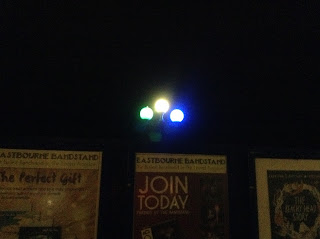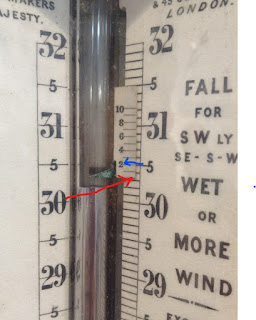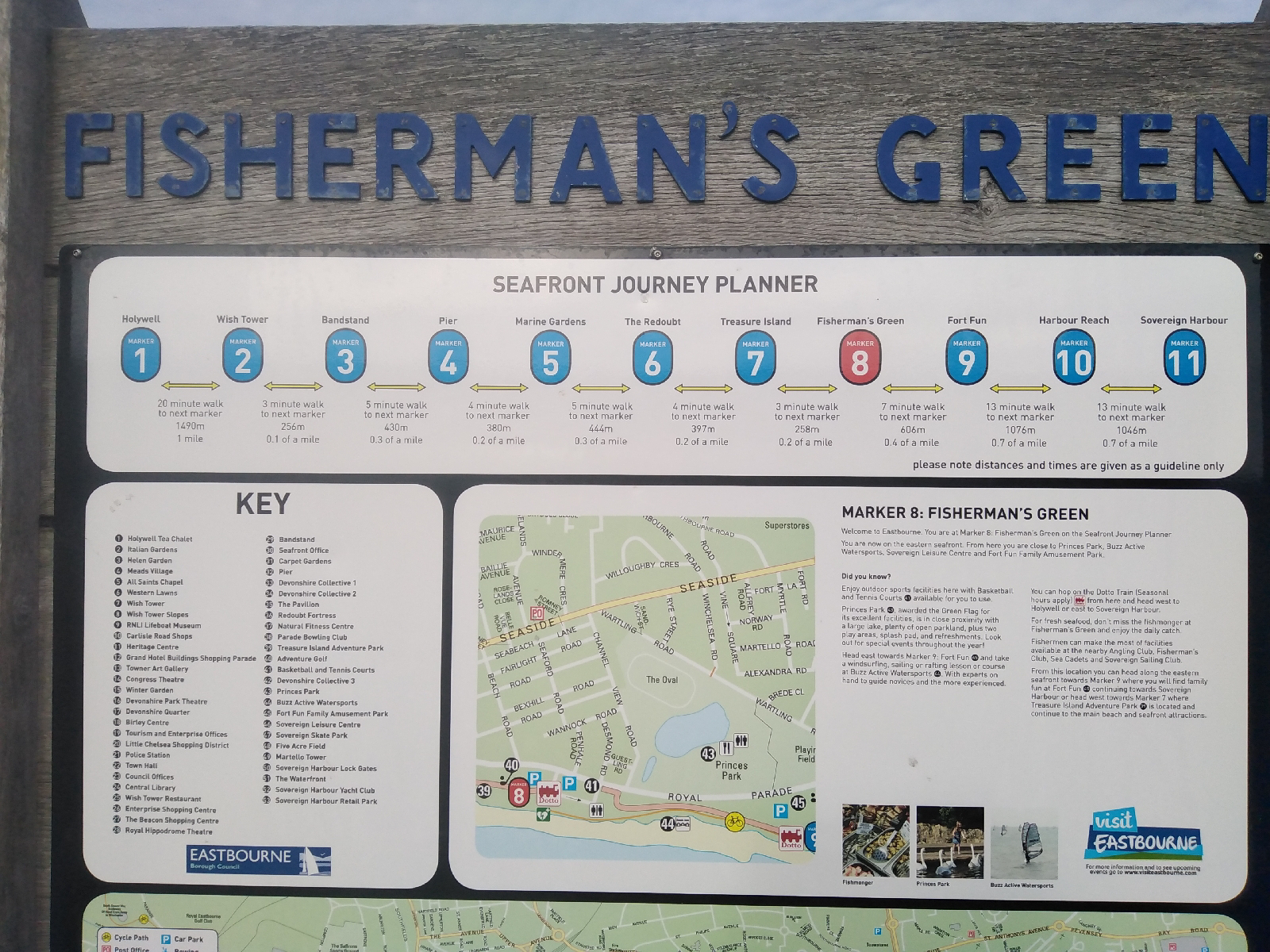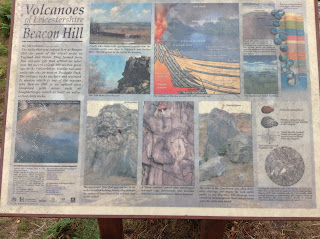Here's a yacht in a special boat lift at Ardrossan marina. The boat needs to be supported because of its keel. Jim Al-Khalili and Johnjoe McFadden use a boat keel as an analogy. They say that classical theories leave the processes inside a warm cell like a boat without a keel. It would get tipped over quickly and so the structures that give us life couldn't endure. They then say that the random statistical processes in fluids are like particles on both sides of a keel but that the keel needs to be deep enough to reach into the quantum world. There the processes in protein bond oscillations that can knock excitons back into coherence and thus allow improbable structures to endure. You'll need to read their full account in Quantum Biology.
Wednesday, 30 November 2022
Tuesday, 29 November 2022
Colour noise on Audacity
I heard of white noise decades ago but I hadn't heard of the idea of colour noise until I spotted it in Jim Al-Khalili and Johnjoe McFadden's book Quantum Biology. I started with this article and have realised this is going to take a lot of unpacking for me. I knew that white noise is supposed to be an equal mix of all frequencies. Then I realised I could experiment with it in Audacity. Here is white noise with its frequency analysis.
Then I found pink noise. Notice that the intensity of the higher frequencies is lower.And now Brownian noise.Now I need to find out what spectral power density is.Monday, 28 November 2022
Learning about Shoreham power station
I learned a few new things reading about Shoreham power station. I taught about coal-fired power stations for over two decades. You burn coal to heat water to make steam to turn turbines. But in this gas-powered station, the gas is burned directly inside the turbine. It's a combustion turbine. This leaves hot exhaust gases and it is these that are used to heat water to make steam to turn another turbine using a heat recovery steam generator.
Saturday, 26 November 2022
Hourglass shape of sunlight reflected on the sea
Mrs B pointed out that the line of reflected sunlight narrows to a neck coming away from the Sun but widens again as it gets near us. If the Sun was a small point source of light in the sky, the light should spread out in a wedge towards us. My best guess is that the Sun is spherical and rays are coming in at different angles. If there are waves at the correct angle, they can redirect rays that were spreading out and down back in our direction. The spreading nearer to us would then be the normal point source phenomenon. Now we've noticed it, we need to see if it repeats and under which circumstances.
Friday, 25 November 2022
Refraction in the bathroom
There was an innovative fix to support the old tap mechanism. Look above for how wide the block actually is.
Now look from the new angle and look at how thin the block appears. This is because the light goes much slower in the glass and so bends considerably when it leaves the glass and comes out into the air to meet my eye. My brain knows light travels in straight lines and projects a straight path, which would result in a thinner looking block. When viewed from straight on, refractive index can be calculated by doing real depth/apparent depth.
Thursday, 24 November 2022
Scattering on the edge
I had a look at the sign above the bar. The bottom is lit up and the inscription but not the main front of the slab. The light was shining vertically downwards from the top. I think that the light travels straight until it hits an edge and then is scattered so that some of it is sent in the direction of the eye. It was too high up to inspect but if that explanation is correct, the name must be engraved into the slab so that it presents an edge which scatters the light.
Wednesday, 23 November 2022
Finding molecules in the street lights
These streetlights on the seafront at Eastbourne made me remember the way that I used to draw molecules in class. Three atoms but two colours would mean only 2 elements in my scheme so this could be H2O
Here is a different arrangement. Ignoring continuity of colour scheme it could be CO2Tuesday, 22 November 2022
Nan Shepherd on dimensions
Monday, 21 November 2022
William Cavendish in Eastbourne
Appropriately we were staying at The Cumberland Hotel. The statue outside in Devonshire Place rang some bells as did the Cavendish Hotel opposite. The statue is of William Cavendish, 7th Duke of Devonshire and listed as FRS. He is the one of the family who was Second Wrangler at Cambridge - ie second best mathematician in his year - and who founded the Cavendish Laboratory and endowed a Physics professorship. The man was a friend of physics, and also of Barrow, it seems. His investments in Barrow-in-Furness are remembered in names like the Devonshire Dock. He lived at Holker Hall - and the Bluebirds play in Holker Street!
Sunday, 20 November 2022
Vernier Barometer at Eastbourne Lifeboat
I've never seen a Vernier on a mercury barometer but I found this in the Eastbourne lifeboat shop. Bottom of the sliding scale shows you where to read on the fixed scale (red arrow 30.3) Then find where the lines on the two scales match up and take the number from the sliding scale (blue arrow 2). Put them together to get 30.32.
Saturday, 19 November 2022
You can't stop time
Friday, 18 November 2022
Looking at the Beacon in the rain
It rained all the way back from the south. Here is the view of Penrith Beacon. I amused myself by timing the wiper blades. It took 24.28s for 20 cycles. My reaction time on that watch is 0.25s. That means the percentage uncertainty in the reading is 1%. I can just about justify 3sf. One cycle is 24.28/20 = 1.21s. By timing multiple cycles I can justify a time to hundredths of a second even though I am not physically capable of timing one cycle on its own to that precision.
Thursday, 17 November 2022
Linear expansion and Brighton i360
This is supposed to be the most slender tower in the world in terms of height to width ratio. I take that means without additional support because Caldbeck mast is more slender but has ties to hold it. I saw a suggestion that the Sun on the south side makes that side expand more and so the tower leans slightly north. Coefficient of liner expansion for steel is about 12 x 10^-6 m per degree Celsius for a 1 metre length. The tower is 162 metres high. This means the south will expand by 2mm more than the north for a temperature difference of 1 degree Celsius. Metal conducts so there can be a massive difference so perhaps the difference will be 1 or 2 cm on a hot day.
Wednesday, 16 November 2022
My first ever game of bingo
I played bingo for the first time at the weekend. Once I got my head round it, I was fascinated by the numbers. I started to gather data far too late in the proceedings but found that on two rounds, it took 30 numbers out to get a line and 70 to get house. That from the maximum of 90. I was wondering whether it would be quicker to house with more people playing so I tried to calculate how many possible sets of 15 bingo numbers there are. The constraints were pointed out to me. There has to be something in each column which are set out units, tens, twenties etc. 6 columns have two numbers and 3 have only 1. I got 8.3 x 10^12. This wonderful website gives 24 x 10^15 - rather a lot more. I think they are asking a subtly different question because they factor in where the blanks go.
Tuesday, 15 November 2022
Beachy Head and the OS National Grid
The weather was amazing on Beachy Head and the views were fantastic.
Whilst we were up there, I noticed a post with this carved into it: TV 5891 9538. It was the TV that foxed me. But it isn't unusual to find OS grid references in locations in the Lakes. It turns out that the letters that denote larger grid squares cover a massive area right out into the Atlantic and across the near continent and Scandinavia. See this. We only use the letters H, N, O, S and T. These first letter squares are 500km x 500km! TV only covers a sliver of the coast but it was this coincidence that made me think about it.
Monday, 14 November 2022
Quantum Zeno Paradox
In the wonderful book Quantum Biology by Jim Al-Khalili and Johnjoe McFadden, they explain why on a microscopic level, the kettle that is watched will not boil. Zeno's paradox was the idea that if you try to catch someone by halving the distance to them in every move, you will never reach them because they will always remain half a move away. In the quantum world, it is slightly different. A watched particle retains its particle nature - you know where it is. When not watched, it also has a wave nature - a wave of probability. This means that there is a much wider space in which it might be. But by watching it, you collapse the wave function and make it stay in the same place. Hence on a quantum level, particles in my kettle would stay on the same level and not reach boiling point. The kettle is too big a system to apply this - it is an analogy - but I was amazed to discover that you can stop radioactive nuclei from decaying by watching them!
Sunday, 13 November 2022
Non-linear scale on Eastbourne Prom
Saturday, 12 November 2022
Camera flash light cone
Friday, 11 November 2022
Mars
Thursday, 10 November 2022
Moons of Jupiter
Wednesday, 9 November 2022
Waves that aren't parallel to the coast
Almost always the waves approaching the coast are parallel. This is because as the waves move into shallower water, they slow down by refraction and thus they change direction. This orientates them so that they are parallel. It occurred to me that in deep water, this can't happen. In a swimming pool there is just an abrupt side so the waves don't refract; they reflect instead. Here at Silloth the tide was high against the prom so there wasn't much chance of refraction. The rollers were almost perpendicular. However, these were long wavelength and there are other much shorter wavelengths that need accounting for and explaining.
Tuesday, 8 November 2022
Quantum Biology and wave nature
In this wonderful book, they make a brilliant analogy that I'd never heard about what the probability wave could be like. They suggest that a famous robber escapes from prison and the police try to track. Obviously the police can guess how far the robber will go in a given time, but that gives them a search area where there is a high probability of finding the robber rather than a definite location. Also, certain types of property might be more at risk of robbery so the probability of finding the robber there will be higher. As time goes by, the area expands so it is like a wave of probability. The weakness in the brilliant analogy, they explain, is that the robber is actually always at one definite location but that is not true for something like an electron until it is observed and the wave function collapses - ie there is certainty not probability.
Monday, 7 November 2022
Precambrian rocks in Charnwood
We went up the Beacon to look down on Loughborough. The board says that the rocks are volcanic sediments that settled in the sea 600 million years ago. This is older that the Lake District. It counts as Precambrian. I am interested in the discussion of life in the Precambrian era because the Quantum Biology book I've been reading talks about the discovery of potential fossils in really, really old rocks in Greenland. The board talks about bedding planes in the rocks, which show the layers in which the ash landed on the seabed. Put later heat and pressure made the mineral crystals mobile and lined them up pointing up out of the beds, often at 90 degrees. This makes a cleavage and in slate is what gets cut to make the sheets.
Sunday, 6 November 2022
Kinetic picture
Saturday, 5 November 2022
Three norths collide!
Here's an interesting quirk from the Ordnance Survey: for the first time ever the three types of north they identify on their maps will coincide - they will all be pointing in the same direction. But only at a certain place and at a certain time! True north means the direction you go to head directly to the geographic north pole - the axis of the Earth's rotation. Because the Earth is curved, these lines get closer together the further north you go. Try drawing lines going from the stalk of an apple to the bottom - they start close but spread apart round the middle of the apple and then come back together again. Now look at a map: all north pointing grid lines are parallel and do not get closer as you head further north. This is an approximation to make curved space sit on a flat paper. It is arranged so that one special grid line is actually true north. Then there is magnetic north. The magnetic pole of the Earth wanders and in the next year or two, there will be times when if you stand on that special true north grid line, your compass will also point along that line. Three norths collide!! It's well explained in this film.
Friday, 4 November 2022
Resolution with rollerblades at Watchtree
This is one aspect of resolution of measuring instruments. The rollerblades were unable to resolve the smaller particles.
Thursday, 3 November 2022
How tall is Caldbeck Transmitter?
We had an interesting walk up to Caldbeck Transmitter. My little finger held out like that subtends1 degree of my vision. That means the mast subtends 8 degrees. I was stood 1500 metres away. By trigonometry, tan(8) = height/1500 so the height of the transmitter is 210 metres. It is actually 337 metres high. Now the first few tens of metres are out of sight over the horizon - you can't see the terminal buildings. But that's now very accurate if I should be expecting say 300 metres. That would need an angle of 11 degrees and there's no way I can get that out of it. If my little finger were worth 3/4 of a degree, it would work. However, the usual problem would be that my finger was not far enough away - that would make the angle bigger not smaller. Perhaps more of the mast was hidden than I'm estimating.
Wednesday, 2 November 2022
Momentum: collisions with coins
When I started teaching, the game of "shove ha'penny" was massively popular. How times have changed! Today I fired coin A into a stationary coin, coin B. Coin A stops and coin B moves on. Try A at different initial speeds.
Then I stuck two coins together.Tuesday, 1 November 2022
Trying a cymatics experiment
I took my inspiration from this film. I realised that I could do the experiment here by prising the front off my stereo speaker and playing sine waves tones generated in the Audacity app. I wasn't expecting anything given the rudimentary nature of the equipment but I was amazed to get patterns that look like those in Nigel John Stanford's film.
Above is 25 Hertz. Below is 50 Hertz. I'm not sure the photographs look much different but it seemed different looking at it.The circular ripples in the film turn out to be a transient feature that appears just at the beginning. Thank you to Kay for telling me about cymatics. Although I've done experiments covered by the term, I'd never heard that word. It is about finding ways to make sound waves visible. I'm keen to try the corn starch and water mix next!
















































